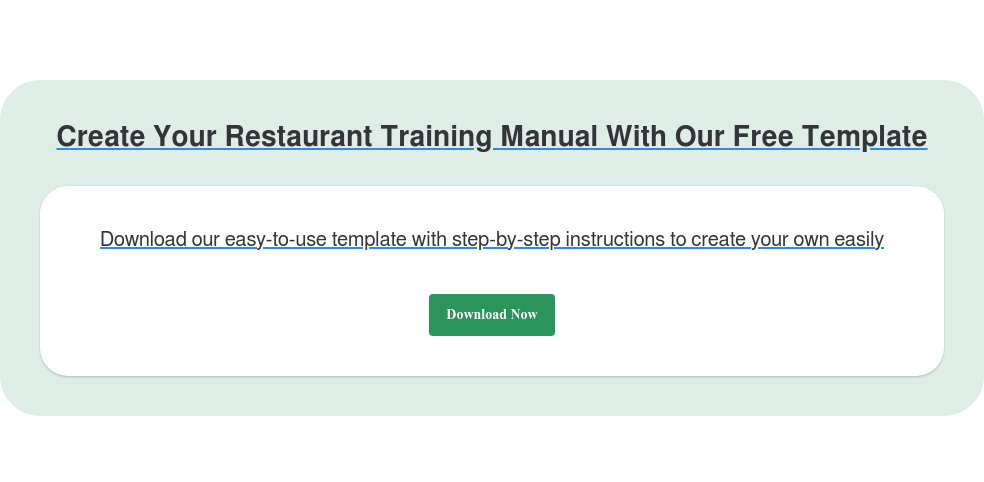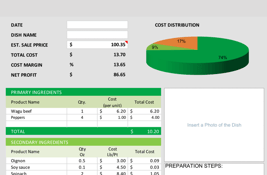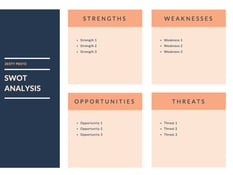Your restaurant training manual should be clear, easy to follow, and cover every part of your operations even the things that might feel second nature to you.
Make sure every new hire reads and uses this training guide, no matter how much experience they bring. It helps build a consistent, high-performing staff. Whether it's your dishwasher or your floor manager, give everyone a copy they can access easily digital or printed, whichever works best for your setup.
Whether you're starting from scratch or refreshing what you already have, the step-by-step restaurant staff training handbook below breaks down everything you should include to get it right.
Key Takeaways
-
A solid restaurant training manual sets the foundation for onboarding new team members.
-
It should include SOPs, company policies, job descriptions and training checklists.
-
Common sections include food safety, customer service, POS system training and opening/closing checklists.
-
Keep it up to date, review it regularly to make sure it's still accurate.
-
Pair the manual with hands-on, in-person training to bring it to life.
-
A well-crafted training guide speeds up onboarding and helps your restaurant run more smoothly.
1. Title page & contents
Make a clean and professional restaurant training manual by starting with a title page and a table of contents. This sets the tone for a well-organized staff training guide and helps new staff members quickly understand what to expect.
Title Page
The title page gives your restaurant staff training guide a polished, branded feel by showing your unique identity like your logo, restaurant name, and address.
Also, include contact information so staff know who to reach out to with questions. This is especially helpful for new employees navigating your training handbook for the first time.
Contents
A table of contents makes it easier for staff members to navigate the training guide. It’s especially useful when they need to revisit a specific section saving time and reducing confusion during onboarding.
Luckily, most word processing programs like Pages or Word let you create a contents list with just a few clicks.
Here’s an example of a simple contents list:
-
Introduction
-
Training guide overview
-
Key responsibilities
-
Technology breakdown
-
Takeaways
Now to showcase what your restaurant is all about and what you stand for, let’s take a look at your mission statement.
Further reading
%20(1).webp?width=800&height=450&name=Eat%20(31)%20(1).webp)
2. Write down your mission statement
The first page of your restaurant training manual should include your mission statement. Many restaurateurs don’t realize how often servers are asked about the restaurant’s values and this is your chance to make sure every staff member answers with clarity and consistency.
Your mission isn’t just a marketing tool it’s the foundation of your staff training handbook and the culture you're trying to build.
If you don’t already have a mission statement, ask yourself:
-
What do I want to achieve? Gain recognition for my service? Build a loyal following with an amazing happy hour menu? It could be both.
-
Who is my customer base? Who exactly am I trying to attract?
-
How am I going to fulfill my mission?
Once you’ve answered these questions, you’ll have a clear, meaningful mission to include in your restaurant employee training guide.
Here's what a restaurant expert has to say about creating a mission statement:
A mission statement is the guiding star of any restaurant, illuminating its values and purpose. It empowers staff with a clear understanding of what the restaurant stands for, which they can then convey to guests, enhancing their overall experience.
>>> Download your free restaurant mission statement here.
3. Introduce your concept
You’ve probably talked about your restaurant concept a lot during the hiring process. In fact, it likely helped guide you in selecting the right candidates from the very beginning.
For example, if you own an Italian restaurant with a jazz music theme, you’ll want your servers to have some knowledge of jazz to enhance the guest experience.
If your restaurant is known for offering an extensive wine list, your staff should be trained and confident in speaking about wines especially the ones featured on your menu.
This section of your restaurant training manual is the perfect place to reintroduce your concept and reinforce what makes your restaurant unique. Use this part of the staff training guide to help employees better understand the ambiance, theme and guest expectations, so they can deliver consistent service aligned with your brand.
Posts from the restaurant
community on Reddit
Further reading
4. Provide your restaurant's history
When writing together your restaurant training manual or staff training guide, don’t just focus on daily operations. Let your history and your culture be the special ingredient that brings your staff together.
Culture is the glue that holds your team together, and it starts with onboarding and training.
Here’s how you can include your restaurant’s history in your training manual:
-
Make your menu memorable: Share the stories behind your signature dishes or the inspiration for your most popular drinks. This turns your menu into more than just a list it becomes a reflection of your restaurant’s personality.
-
Highlight your values: Use your history to show what matters to your brand. If community is a core focus, mention your local partnerships or charity efforts. If sustainability is part of your mission, share how you source ingredients or reduce waste.
-
Celebrate your staff: Include stories about past employees who’ve grown within your restaurant. This shows new hires that your workplace offers opportunities for development and recognition.
Your history isn’t just about the past, it shapes your future.
When you include it in your restaurant staff training handbook, you’re not just teaching tasks you’re helping to create a staff that feels connected, purposeful, and proud to be part of your story.
Further reading
5. Divide your restaurant training manual into clear sections
Ideally, you’ll have a different training manual or section for each role at your restaurant, servers, bartenders, kitchen staff, managers and so on.
That doesn’t mean you need to start every restaurant staff training handbook from scratch. You can save time by using shared content across positions, then adding role-specific training instructions.
If you already have a restaurant operations manual, much of this shared content like your mission statement and concept can be repurposed here.
Creating separate manuals for each position in your restaurant ensures that each team member receives tailored training and guidance. However, by incorporating standard sections such as the mission statement and core policies, you streamline the process and maintain consistency across the board. This approach not only saves time but also reinforces the unified vision and standards of your establishment.
Further reading
Examples of standard sections:
-
Expected behavior: Let new hires know what’s expected and what won’t be tolerated. This sets clear expectations around workplace conduct and shows which behaviors are rewarded.
-
Dress code: Outline guidelines for uniforms, shoes, hairstyles, piercings and accessories. A clear dress code supports both branding and hygiene standards.
-
Health and safety procedures: In addition to food safety, explain how to respond to common health-related incidents (e.g., a customer choking, a colleague fainting). This section of your training guide supports staff confidence during emergencies.
-
Food preparation knowledge: When servers can’t answer questions about ingredients or allergens, it affects the guest experience. Ensure all staff are familiar with your menu and encourage them to taste dishes during training.
-
Payroll and HR basics: Include details on work hours, time tracking, PTO and Worker’s Compensation. This helps reduce confusion and ensures your training manual supports transparency.
-
Emergency procedures: In case of fire, natural disaster or other emergencies, staff should know the exact steps to follow. Include evacuation maps, contacts and safety protocols.
Examples of sections for a server’s training handbook
-
Customer service: Beyond smiling and greeting guests, outline how to describe the menu, offer personalized recommendations, handle complaints, and politely upsell. Great restaurant customer service training starts here.
-
POS system usage: Teach servers how to enter orders, split checks, tip runners/bussers, and review their sales performance. Include screenshots, written steps, or links to digital resources for smoother POS training.
-
Cash handling procedures: Prevent errors and losses by clearly explaining how to count cash, verify bills, log tips and manage drawer limits. Reinforce this part of your server training guide with examples or short videos if available.
-
Staff policies: Cover day-to-day expectations like side-work duties (e.g., prepping the salad bar), tip pooling and opening/closing routines. Also, explain guest-facing policies like late arrivals, no-shows or table turn rules.
Further reading
6. Add checklists
Checklists are one of the simplest and most effective tools you can include in your restaurant training manual. They break complex tasks into easy, actionable steps, helping trainees learn faster and more confidently.
They’re also invaluable for performing quick pre-service checks or responding in high-pressure situations. A well-structured restaurant staff checklist ensures consistency and quality throughout the shift.
%20(1).webp?width=800&height=450&name=Eat%20(33)%20(1).webp)
Here’s an example of a front-of-house checklist, covering key moments in the cycle of service.
You can expand this format to cover an entire shift including opening procedures, closing duties, and post-service wrap-up.
Before the shift
- Check the cleanliness of your area
- Check the cleanliness of the station
- Check that all menus are clean
- Check restrooms
- Check that tableware is clean, and that glassware and dishware are not chipped
- Check that tablecloths and napkins are clean
- Study specials to be ready to answer customers’ questions
- Discuss any issues with the manager
Welcoming guests
- Greet guests with a smile
- Introduce yourself with your first name
- Take special care for elderly guests, guests with disabilities, children, expectant women, etc.
- Stay within arm’s length of the customer as you’re escorting them to their table
Further reading
Taking orders
- Take orders starting from the drinks and suggestively sell an appetizer
- Give menus to ladies first and then continue clockwise
- When there are multiple guests at the table, take the order from left to right
- If they seem to be in a hurry, suggest menu items that take less time to prepare
- Let customers know if a dish they ordered requires more time
- Repeat the order back to the customer
- Ask guests who haven’t ordered appetizers whether they prefer to wait or receive the main course with the rest of the items
During service
- Check back every 20 minutes to ensure everything is OK
- Be alert for any signs of discomfort or dissatisfaction. Discuss with your manager if necessary
- Clean the table for dessert from the guest's right side with the right hand, and then transfer it to the left hand.
- Remove bread and butter, soiled dishes, cutleries, and condiments
7. Add training goals and a final review
To make your restaurant training manual more effective, include clear learning goals at the beginning of each section. These goals help employees understand what’s expected and give them something concrete to work toward.
Examples of restaurant training goals include:
-
Recalling the mission statement
-
Memorising key ingredients in recipes
-
Understanding how table numbers are organized in the dining area
Setting these staff learning objectives at the start of each section keeps the training focused and actionable.
At the end of the staff training handbook, include a final review or test that covers all or most of the content. This helps reinforce learning, identify knowledge gaps and ensure consistency across the staff especially for new hires.
%20(1).webp?width=800&height=450&name=Eat%20(32)%20(1).webp)
8. Include resources for cross-training
How many times have you had your only host call in sick & no one available to step in?
If that’s happening more often, it’s time to think about cross-training restaurant staff so they can confidently step into other roles when needed.
Use your restaurant training manual to outline the basic responsibilities and procedures of key roles like host, busser, or line cook. That way, staff members can refer back to clear documentation when asked to cover another position even temporarily.
Including cross-training resources and job role protocols in your staff training guide creates a more agile, resilient staff. It also supports better collaboration and ensures service standards stay consistent, no matter who’s on the floor.
9. Include a release to sign
At the end of your restaurant training manual, include a section where new hires sign a release stating they’ve read and understood the training procedures. This employee training acknowledgment is essential for confirming that staff are aware of your expectations and operational standards.
Alongside the signature, include a disclaimer clearly stating that the manual is not an employment contract.This helps protect your business while setting boundaries around your training materials.
Be sure to give each new hire a copy of this signed acknowledgment page for their own records before they begin work in the kitchen or front of house. This step ensures a more structured and legally sound restaurant onboarding process.
Having new employees sign a release after reading the manual ensures they are aware of and understand the training procedures. It’s also essential to include a disclaimer stating the manual is not an employment contract. This protects both the employer and the employee, clarifying expectations and responsibilities from the start.
5 tips to improve your restaurant training manual
Once you understand the process of creating a restaurant training manual, the next step is to find ways to make it more effective and engaging for your staff.
After all no one wants to read a handbook that’s dry, text-heavy or forgettable. The goal is to create a restaurant staff training guide that’s not only informative but also easy to follow and enjoyable to learn from.
%20(1).webp?width=800&height=450&name=Eat%20(34)%20(1).webp)
Here are a few things you can do.
- Give it a fun name: Show your personality by calling your manual something like “The Playbook” or “Our Best Secrets.” A lighthearted title can make the employee training experience feel more approachable and less intimidating from day one.
- Add summaries & previews:Once you’ve built out the main content of your training handbook, include chapter previews and end-of-section summaries. These help employees retain key information and make it easier to revisit what they’ve learned.
- Relate it to real life: Use real-world examples and everyday restaurant situations that new hires will likely encounter. This makes your manual feel more relevant and practical.You can also incorporate role-playing scenarios it takes a bit more effort but delivers excellent results in reinforcing learning.
- Use visual training aids: Don’t underestimate the power of a good image or screenshot. If your training guide covers digital tools like your POS system or back-of-house software, show step-by-step instructions with visuals. You can also include photos for cleaning routines or equipment setups.
- Explain the "why": People are more likely to follow through when they understand the purpose behind a task. Don’t just tell employees what to do explain why each step or policy matters. Whether it’s food safety, guest satisfaction, or staff efficiency, giving context builds buy-in.
Example of a restaurant training program
An employee training handbook, while important, should be just one part of a broader restaurant training program one that blends theory with hands-on experience.
Below is an example of a structured, three-week new hire training schedule, including a detailed daily plan for Week 1 and learning goals for Weeks 2 and 3.
Training doesn’t end there, of course. It should be an ongoing process with regular updates on menu items, service procedures, and situational problem-solving.
Week 1: Daily staff onboarding plan
Day 1
-
Tour of front-of-house and back-of-house areas
-
Lunch with menu sampling
-
Station tour and shadowing
-
Study appetizer recipes
-
Review the restaurant training manual
Day 2
-
On-the-job training shift
-
Lunch (menu sampling)
-
Study main course recipes (Part 1)
-
Learn food safety and hygiene procedures
Day 3
-
On-the-job training shift
-
Lunch (menu sampling)
-
Watch demonstration of safety and sanitation processes
-
Study main course recipes (Part 2)
Day 4
-
On-the-job training shift
-
Lunch (menu sampling)
-
Study dessert menu
-
Review remaining sections of the training handbook
Day 5
-
On-the-job training shift
-
Final test – Part 1
Test topics:
-
Dining room layout and table numbers
-
Mission statement
-
Proper table setting and service basics
Day 6
-
On-the-job training shift
-
Final test – Part 2
Test topics:
-
Food safety best practices
-
Recipe ingredients, cooking times, and prep steps
-
Review with direct manager or training supervisor
Goals for weeks 2 and 3
-
Bridge any training gaps from Week 1
-
Recite the wine list and recommend pairings
-
Identify various meat cuts
-
Know ingredient substitutions for common dietary needs
-
Begin cross-training in another role (e.g., host, runner, busser)
-
Practice responses for real-life challenges like:
-
Handling an argument over a check
-
Responding to dine-and-dash attempts
-
Assisting a guest who faints
-
Dealing with a power outage during service
-
Managing a spilled drink incident at a table
-
Takeaways
Creating a restaurant training manual might feel overwhelming at first — but once you know what to include, it becomes much more manageable.
Yes, it does take time and effort to put together. But the cost of a poorly trained employee in mistakes, lost guests, or low morale can be far greater in the long run.
On the flip side, when you clearly document how your restaurant operates and how staff should carry themselves, your restaurant training guide can help you:
-
Deliver a consistently high-quality dining experience, leading to better retention, guest referrals, and ultimately, more revenue
-
Foster a safe, supportive and productive work environment for your entire staff
-
Protect your business from legal risks by outlining expectations and procedures clearly
-
Reduce employee turnover by making onboarding smoother and setting staff up for long-term success
Want to get started with your employee training manual? Download our handy training manual template below. 
FAQs
What is a restaurant training manual?
A restaurant training manual or an employee handbook is a guide that outlines the job role, rules, regulations, policies, and guidelines of your restaurant for your new hires and helps management train them in a standardized manner.
Every time a new staff member is hired, the management can take them through all the training steps per the training manual, ensuring no important information is missed.
It also gives employees something to look back on to reinforce their responsibilities and the restaurant's ethics and etiquette without storming their managers with a thousand questions every day.
Creating such an important document can be challenging, though: where do you start? Who will it involve? Just the task of conducting basic research may be enough to make even the most motivated restaurant owner’s eyes droop.
Why do you use a restaurant training manual?
A high-quality training manual serves as a valuable resource for all employees, easing the stress of training new staff for both trainers and trainees. New hires can review their training manuals at home and on-site, familiarizing themselves with their job descriptions and the specific nuances of their roles. Employee turnover is a significant challenge in the restaurant industry, but enhancing your onboarding process can boost employee satisfaction and retention. A well-developed, clear, and detailed training manual is essential in achieving this goal.














.webp?width=200&name=v2-15mknc-qpw1b%20(1).webp)
.webp?width=200&name=v2-15kqni-p0exl%20(1).webp)
-1.png?width=1812&height=1072&name=TripAdvisor%20%26%20More%20Bookings%20(1)-1.png)
-2.png?width=1812&height=1072&name=Google%20Bookings%20(1)-2.png)


-1.png?width=200&name=TripAdvisor%20%26%20More%20Bookings%20(1)-1.png)
-2.png?width=200&name=Google%20Bookings%20(1)-2.png)
-1.png?width=200&name=Instagram%20Bookings%20(1)-1.png)
-1-png.webp?width=200&name=Facebook%20Integration%20Rectangle%20(1)-1-png.webp)







.webp?width=200&name=download%20(1).webp)
%20(1)-2.webp?width=200&name=Eat%20(34)%20(1)-2.webp)
%20(1)-2.webp?width=200&name=Eat%20(18)%20(1)-2.webp)





.webp?width=670&height=440&name=Restaurant%20Training%20Manual%20(1).webp)



%20(1)-1.webp?width=314&height=175&name=Eat%20(62)%20(1)-1.webp)


.webp?width=144&height=72&name=Eat%20App%20Logo%20(3).webp)